Cables are often overlooked in the world of home audio, and however, many audiophiles find that cables can have a significant impact on their sound quality.
This article will cover the basics of coaxial speaker cable and an in-depth guide about it.
A high-quality coax speaker cable can make a significant difference in the sound of your music.
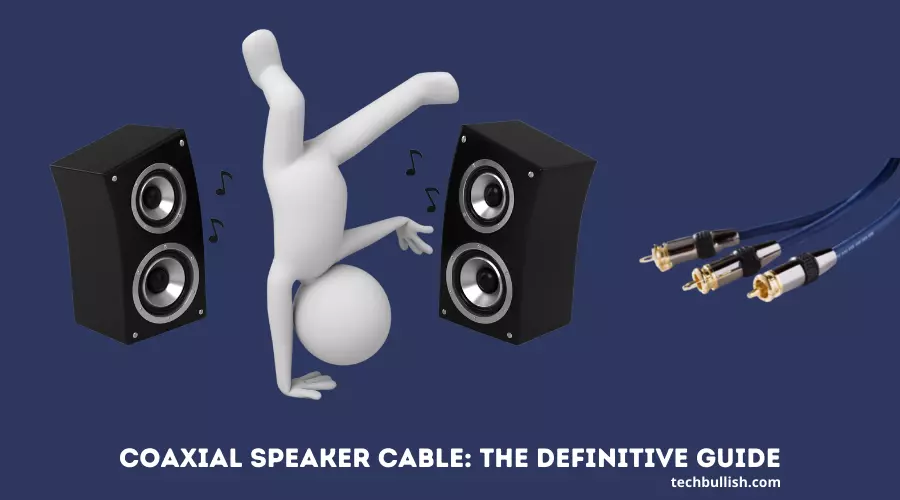
The right cable can help to ensure that your music sounds clean and clear, while also providing the power you need to get the most out of your speakers.
Why Should you Trust Me? Hi, I am Anirban Saha, an Engineer with a Specialization in Electronics and Communication Engineering. I have experience in Smart TVs, Electronics circuits, and Computer peripherals.
Let’s get started!
What is Coaxial Speaker Cable?
A Coaxial Speaker Cable is a type of Electrical Cable that transmits audio from Input Source to Output devices like Speakers, Home Theatres using RF signals. The transmission bandwidth coaxial cable ranges from 20KHz to 300 GHz.
The audio transmitted by Coax Speaker Cables does not get affected by external Electromagnetic Interference. So, you will get a more clear, more prominent audio output from the speakers.
The Audio would be more lively with better mids, highs, and lows.
Fog E.g.: For S/PDIF Audio Connectors, the signal is sent using a Coaxial cable with RCA connectors.
It is also known as a Coax Speaker cable. The term Coax is often used in place of the term Coaxial.
In addition to being used to transmit audio and video signals, you can also find speaker cables on TV antennae, modems, and cable boxes.
In 1858, the cable was used for the first time, but it wasn’t patented until 1880. It didn’t take long for cable to become the standard for household and office communications.
The first cable was composed of copper wire twisted together. The metal wire was the waveguide, which was the first coaxial cable.
By the mid-1800s, the wire was replaced by a solid metal tube of the same diameter as the coaxial cable.
A small hole in the center of the metal tube allowed for a connection to the center conductor of the coaxial cable.
The first coaxial cable was used to send television signals. It was the first practical way of transmitting TV signals.
A coaxial cable was more practical for carrying signals over long distances because it was immune to interference, and you could use it to carry the signal. The metal wire also made the cable tough and flexible.
What does Coax cable look like?
You can describe the shape of coaxial cables as cylindrical and straightforward. Every coaxial cable has the same four essential components, regardless of its thickness, color, or complexity of structure.
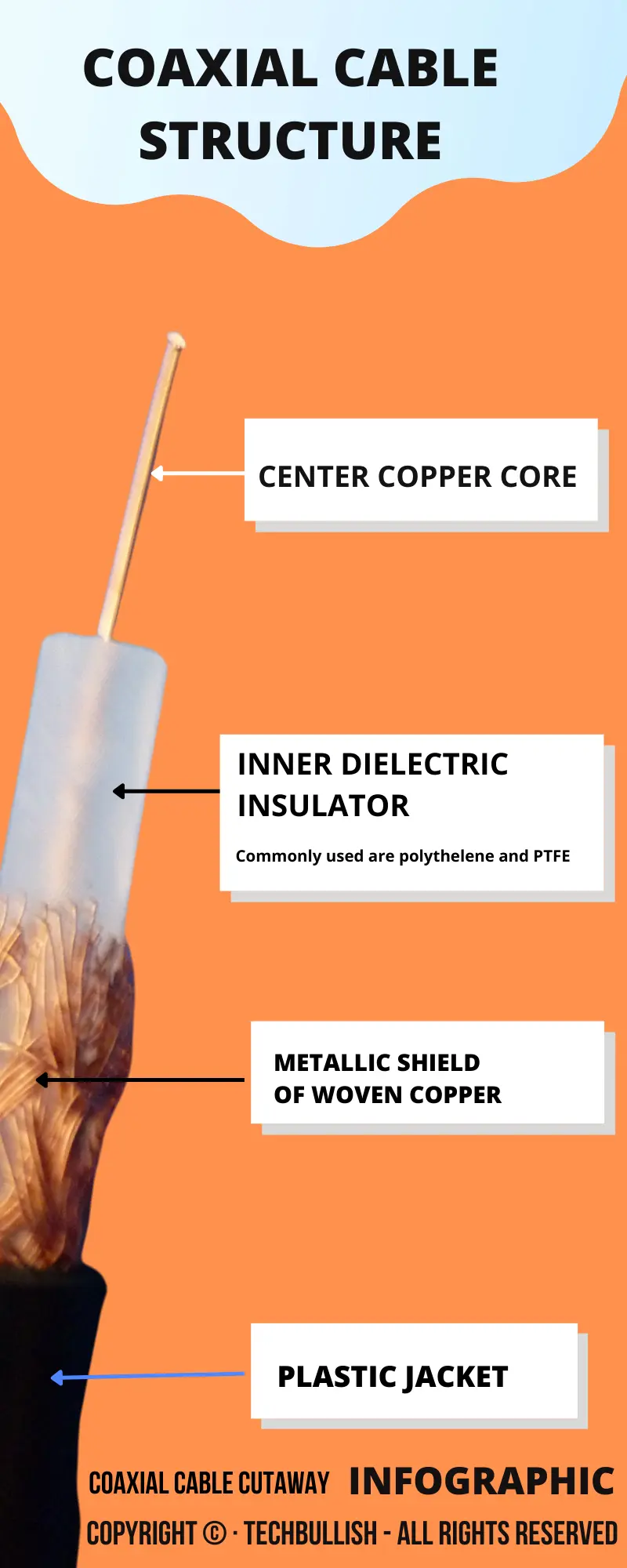
There are four elements in a Coaxial Cable. Those are:
- Conductor at the heart of the circuit
- The dielectric insulator
- A metal-encased helmet
- PVC-coated outerwear
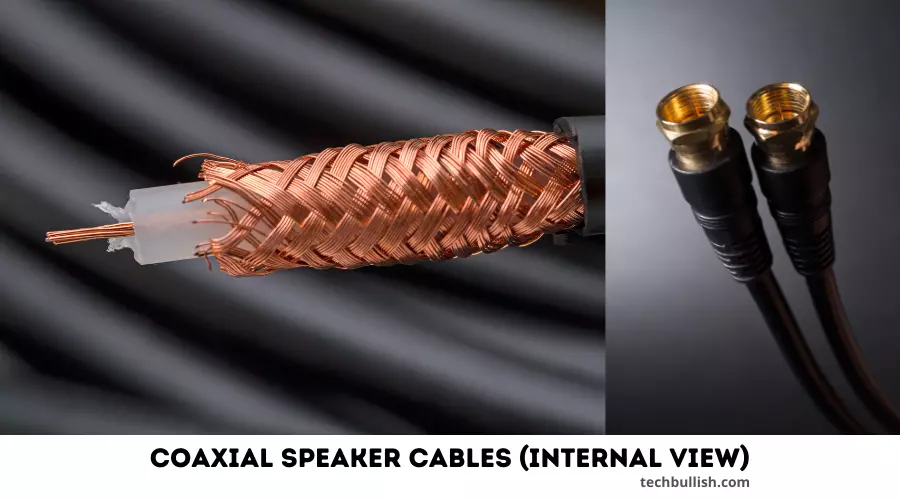
The first component is a center conductor, and the metal wire inside the cable does the actual job of carrying the signal.
The core is typically made of copper. This line carries the signal, and it also acts as the ground for the cable. Additionally, steel with a copper coating and stranded copper is frequently used.
A dielectric insulator surrounds the core conductor. Plastic, foam, or air with spacers can all be used as this insulator’s constituent parts.
The outer layer is a PVC-coated sheath, which is usually flexible and stretchy.
Copper braided wire is the material of choice for shields in most cases. Occasionally, it’s made of silver-plated wire.
A braided copper wire and an aluminum foil shield are standard in high-quality cables. Even four layers of shielding are possible, with two layers of aluminum foil and two layers of braided copper wire.
Losses are reduced and enhanced, but the cable becomes thicker and less flexible, which isn’t always good.
“Jacket” is a common term for the final layer, PVC. You can also use Fire-resistant material, a material resistant to oxidation and ultraviolet light, or water-resistant materials in the jacket’s construction.
Cables containing optical fiber will have special jacketing, as will cables that include wire-bound and twisted-pair wiring. Cables with a PVC jacket are used for almost all cable installations.
Cables are generally terminated by connectors attached to terminals and conductors. You’ll find a wide variety of cable types.
What types of connectors are used for coax cables?
Different types of cables require different connector types depending on the application.
Coax connectors are available in many varieties but are commonly used are:
- N-Connector
- BNC Connector
- SMA Connector
- F-Type Connector
- RCA Connector
BNC connectors are used in RF and video applications. It can be used with frequencies as high as 10 GHz – it will stay stable until 4 GHz – it will radiate a signal, and losses will rise.
The N connector can be used at lower frequencies up to 18GHz. The RF system is utilized in a variety of applications (communication and broadcast equipment). SMART connector.
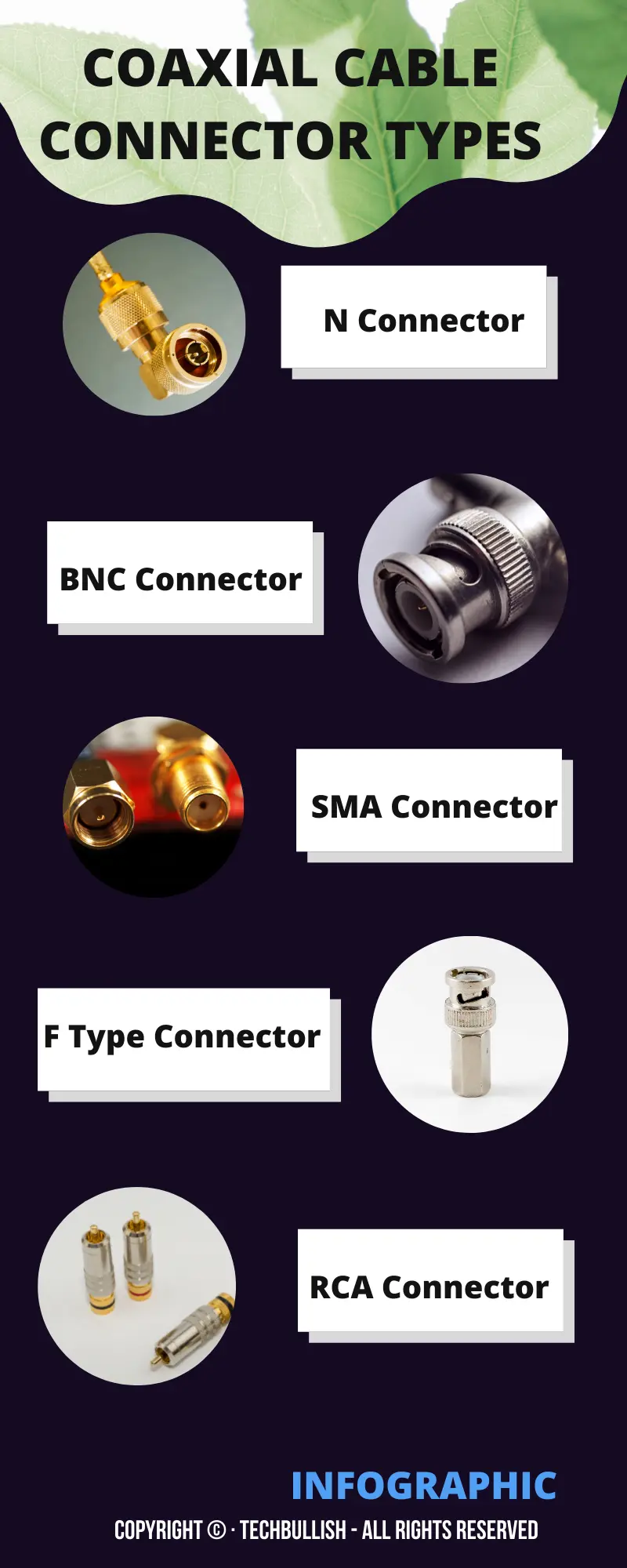
Purpose of Coaxial cables
Coaxial cables have been used extensively for video and information transmissions. In the past, the antenna has been linked to the Internet as a feeder line.
When compared to other transmission lines, these have multiple disadvantages.
They’re very effective on high frequencies, and in cases, with low attenuations, these can be frequently utilized. Diffusion-free transmission can be achieved through certain designs.
The cable needs fixing to the electronic component for installation. Despite that, there were few.
Is Coaxial audio good?
Audio cables are the backbone of any audio system. The quality of these cables will have a significant impact on the audio experience, so it is essential to know what type of audio cable you are using.
A coaxial speaker cable, sometimes called coax for short, is an audio wire used in audio systems.
Coaxial cables are designed to carry high-frequency signals with minimal distortion. A coaxial connection is superior to optical, allowing for more detail and more excellent dynamic range in terms of audio quality.
Because it has more bandwidth available, it can support 24-bit/192kHz audio up to this point.
Cables are also available in different gauges. Some audio systems will use only the highest-possible gauge, such as 18-gauge, and others will use multiple gauges for various purposes.
If your devices have coaxial cables and want high-quality audio, you can use them.
If you have HDMI access on your device, we generally recommend using it because it supports a wide range of formats. You can use the coaxial connector if your device does not have this connector.
In addition to 5.1 surround sound and standard stereo, you’ll be able to hear audio through a coaxial connector. Getting high-quality audio via coaxial is also a viable option.
This is not the best option unless you need a connection that supports lossless formats.
Lossless formats such as Dolby Atmos, Dolby Digital Plus, and Dolby TrueHD cannot be transmitted over coaxial cable.
An HDMI cable and connection are required for these types of audio formats, and this can be an additional cost if you need these high-quality audio formats.
You may need to buy a new HDMI interface if you decide to use a connection that supports lossless audio formats.
Coaxial audio cables cannot handle high bandwidth and transmit audio signals muddled with noise. HDMI and Optical cables are the best options to transfer digital audio files from one device to another.
The cables can handle the high bandwidth necessary for audio, and they can also be cabled to multiple devices simultaneously, and this is one of the main reasons they are more popular than any other cable.
What’s better, HDMI or coaxial?
As many people know, you can use coaxial and HDMI cables simultaneously.
If you want to connect your computer to the television, you can connect it with an HDMI cable and connect your computer to the TV with a coaxial cable.
However, there are a few differences between the two.
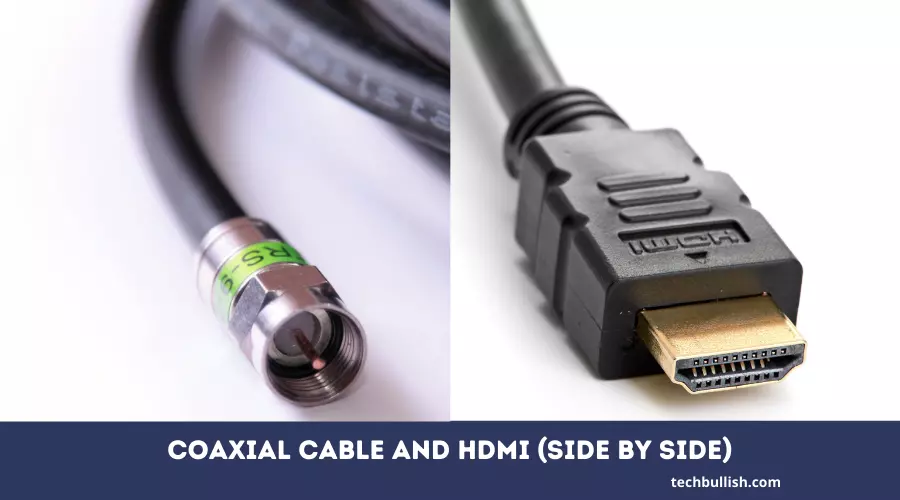
The HDMI cable is better. Since its introduction in 2002, the HDMI (high definition multimedia interface) has become a widely adopted connectivity standard. Plug-and-play HDMI cables are available with a 19-pin connection.
They have ten top pins and nine bottom pins in a simple structure. They’re plugged into the HDMI port like a USB drive to make a connection. They transmit digital information.
Using HDMI cables instead of coaxial cables will result in better picture quality. This occurs because HDMI cables are made for equipment design and data handling.
The shield conductor is grounded at both ends of a coaxial cable and surrounds the center conductor.
The signal on the inner conductor is unaffected by RF interference and noise. Noise reduction over long distances is made possible by using a coaxial cable.
It is possible to divide a signal into different frequency bands, and long cables do not affect the signal quality.
An HDMI cable transmits quality digital video and audio in a specific format to the wires and connectors used in its construction.
Noise, congestion, and security issues can arise during installation because the bus topology of coaxial cables and HDMI cables do not have these features.
Can a coaxial cable be used for the speaker wire?
Although coax can be used as a speaker cable, the process is inefficient. Make sure you use RCA connectors instead of the standard F-connectors for your setup.
Powered subwoofers work best, but any speakers should work in theory.
Impedance load on the amplifier is an issue when using coax as a speaker cable, and you won’t drive it as hard because of the increased setup resistance.
Taking the risk of destroying everything in the process will yield results. The greater the distance between you and the cable, the greater the risk.
Keeping your equipment as close to the coaxial cable as possible is the best way to minimize risk. You’ll have a sound-producing routing experience if you keep things in the kHz range.
Wiring your system may not produce the sound quality you expected, and you can use the coax if you have no other option.
Speaker wire vs coaxial cable
Because of its accuracy and dependability, coax has become the standard for data transmission, and the product’s popularity stems from its unique shielded design.
Although fiber optics and other 21st-century innovations will never compete with coax as a speaker cable resource, you can use it at home.
The main difference between coax speaker cables and RCA audio cables is that the former transmits analog signals, whereas the latter does not.
As a result, they provide more bandwidth to ensure a more stable connection. Compared to standard audio cables, the external cable has a higher level of durability and robustness.
Some systems have an audio and video output that you can use in a home theater setup.
Coaxial cables aren’t just for video; You can use them for a wide range of other things as well.
Despite its lack of flexibility and overall thickness, you can use it as your speaker wire if you take the necessary steps.
What can you use coaxial cable for?
Video and data transmission over coaxial cables is a common practice. To connect antennas, internet connections, digital audio, and cable television signals have traditionally been used as feed lines.
When compared to other kinds of transmission lines, they offer numerous advantages.
At high frequencies, they are very effective, and when attenuation is poor, they are frequently used. Diffusion-free signal transmission is possible with some designs.
It’s difficult to install because the cable must be screwed onto the electronic unit. Despite this, there aren’t many of them.
Another drawback of coaxial cables is that they are incredibly bulky and cannot be reduced in size, so there is only one standard size.
Types of Coaxial Cables
Standard Coaxial cables transmit data over TV connections, Coaxial Ethernet Networks, and other types of cabling systems.
There are many different types of coaxial cables based on their impedance, thickness, construction, purpose, dielectric type, the type of connectors they end with, etc.
The type of coaxial cable you should choose depends on the use area, and it is essential to know what type of coaxial cable you are using before installing it in the cable plant.
Cable type is the main factor determining the performance and the price of a coaxial cable.
Let’s take a look at the different types of coaxial cables:
RF
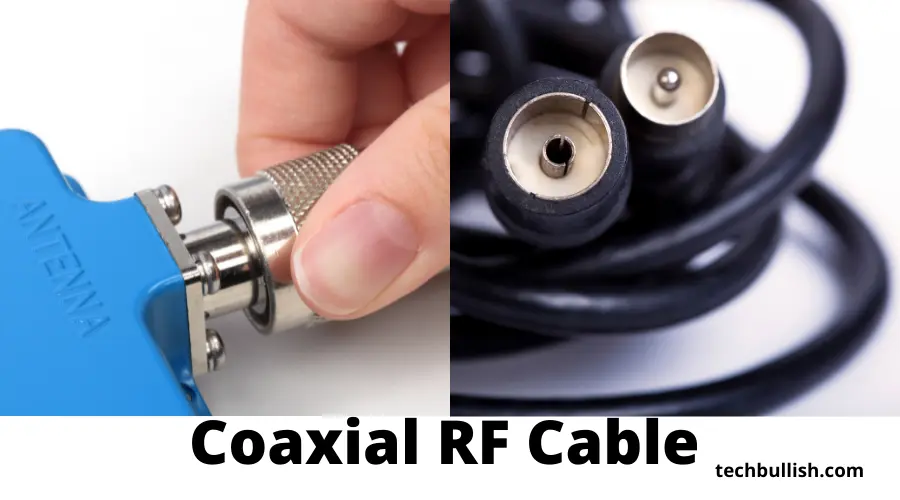
The single pin that plugs into a device’s RF input distinguishes these cables from other types of TV inputs. These are used in transmitter antennas as well as radio transmitters.
RG-6
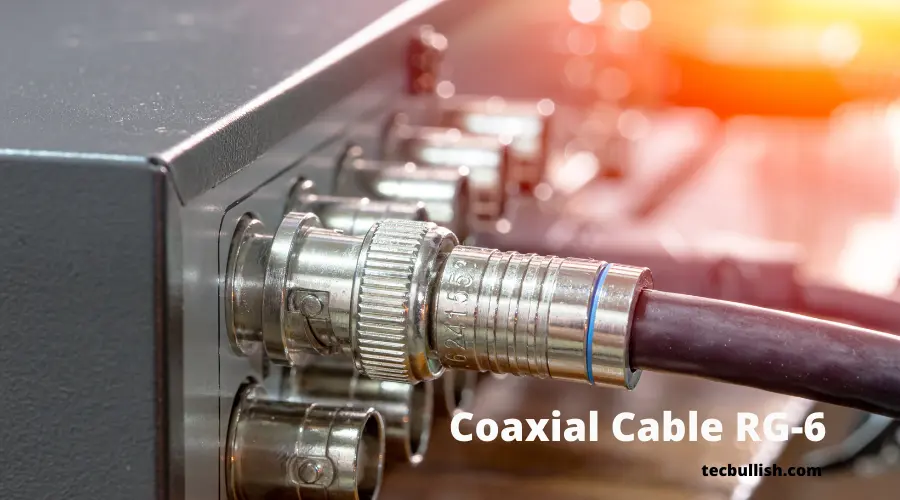
RG-6 High-bandwidth, high-frequency applications such as internet connections, cable TV, and satellite TV signals require thicker wires with special insulation and shielding.
RG-59
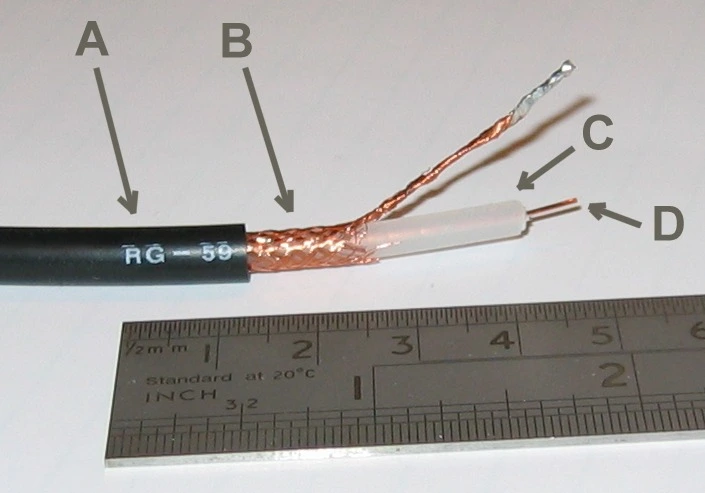
RG-59 cable has a lower AWG wire count. RG-59 has been used for a while, initially used for cable TV connections.
Older commercial office buildings and residences are familiar places to discover this fungus’s spores.
Low-bandwidth and low-frequency signals, like analog video and CCTV, are ideal for this type of transceiver.
RG-11
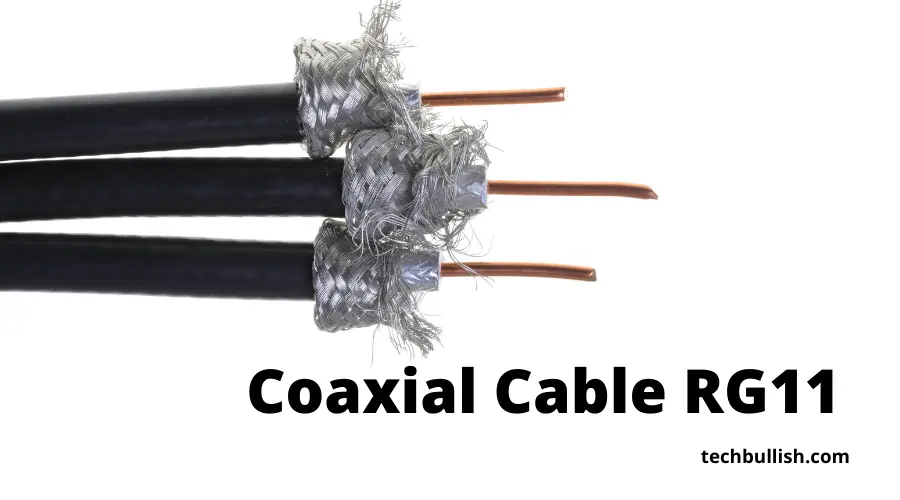
RG-11 is the thickest coaxial cable available, and it isn’t easy to work with because of its flexibility.
But the attenuation level of RG-8 is much lower, making it an excellent choice for long-distance data transmission.
Digital Optical (TOSLINK) versus Coaxial Digital Audio Cable
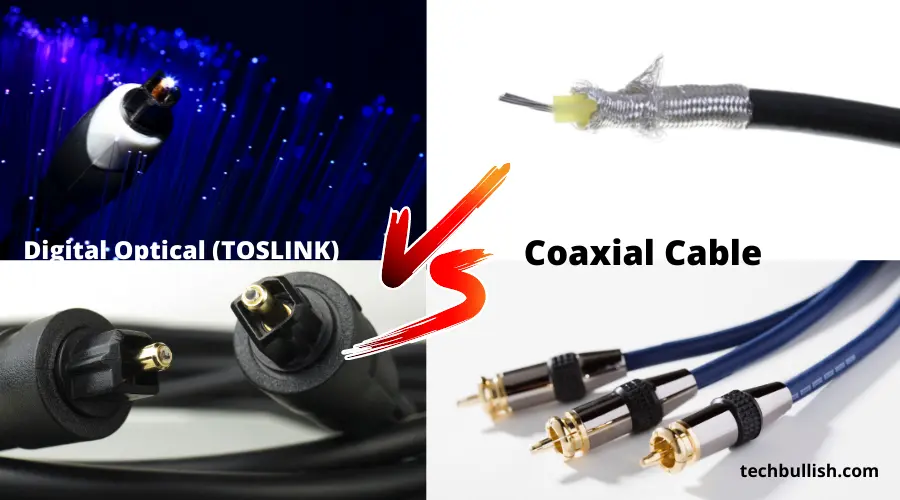
Digital Coaxial Audio Cable also known as TOSLINK is an audio interface that is used to transmit audio over Optical Fiber or Digital Coax Cable.
The digital coax cable has an impedance of 75 Ω(ohm) and carries only audio.
The optical connections may be more commonly used when digital audio is used but most computers have optical connections as well as coaxial connections. Can we distinguish the two? First, there’s a clear difference.
The cables differ, the wires have different structures and the operation methods differ. Cables with optical fibers transmit light and do not have electrical signals.
The cables transmit electrical light pulses that pass between the source and destination devices. There are also a number of other significant performance differences as well as durability differences.
Are Coaxial and RCA the same?
No, to connect RCA devices, a coax cable is used. The actual RCA connectors clearly show that RCA was designed with coaxial cables.
The coaxial cable’s primary conductor is connected to the circular metallic ring on the cable’s outer perimeter by a core conductor.
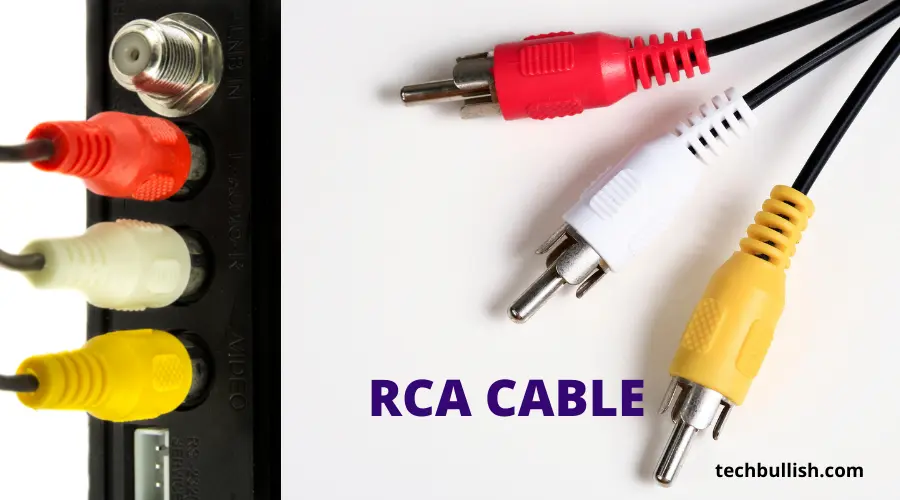
Most often, the second conductor outside of the middle conductor is used to ground or protect signals from reaching it.
In addition to RCA cables, coaxial cables have seen a wide range of applications in the past, especially for RF (Radio Frequency) applications due to the excellent noise isolation they provide.
Old analog cable TV systems and ham or CB radios are good examples.
However, it was phased out of telephone and computer networks.
- Coaxial and RCA are two different types of connectors.
- RCA uses coaxial cables.
- You can use coaxial cables for more than just RCA connections.
- Coaxial is still widely used, whereas RCA is obsolete and out of date.
Pros and Cons of Coaxial Speaker Cable
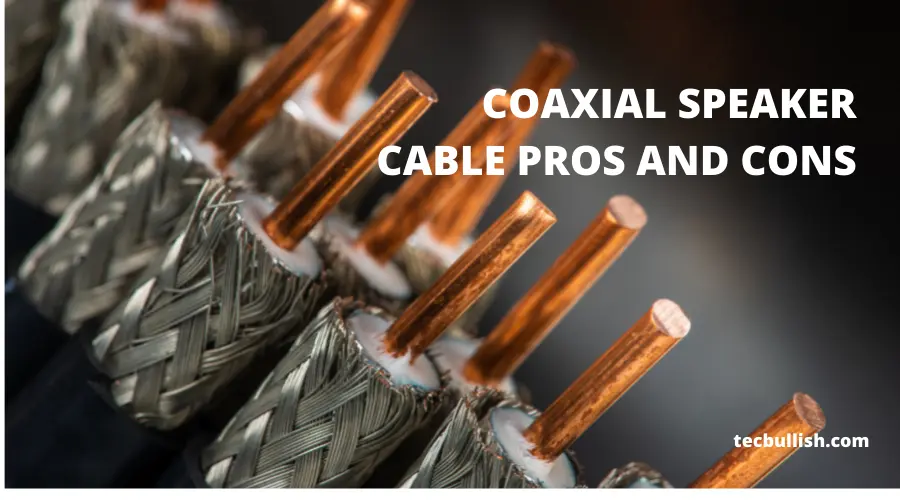
Using a coaxial cable is the best option because of its unique design and construction. Coax cables are less susceptible to electromagnetic and radio-frequency interference because of their excellent shielding and outer jacket.
You can accommodate high-frequency applications using coax cable construction (50 MHz and higher).
Finally, compared to twisted pair cables, coax cable offers greater bandwidth and transfer rates. As a result, coaxial cables are a cost-effective option that is easy to install and expand.
Advantages:
- Affordable: The best thing about coaxial speaker cable is available across the board and in various lengths. Easy to install: Since the coaxial speaker cable is available in different diameters, the process of installation is straightforward.
- A cinch to set up and expand
- Durable
- Anti-EMI and RFI tampering properties.
- Applies a high-frequency signal to the system
- Transmission with a large bandwidth
- High-speed data transfer: The quality of coaxial speaker cables is a class above traditional copper cables.
Disadvantages:
- It must be rooted in reality.
- As a result, the installation is much more difficult.
- The entire network goes down if one cable fails.
- How to Use a Coaxial Cable as a Speaker Cable
Some systems have an audio and video output that you can use in a home theater setup. Coaxial cables aren’t just for video; you can use them for a wide range of other things as well.
Despite its lack of flexibility and overall thickness, you can use it as your speaker wire if you take the necessary steps.
- Disconnect the wires by pulling them out from the connectors.
- Measure the distance.
- Remove the outer covering.
- Remove the braided shields.
- Take out the insulator.
- Cutting and stripping approximately 1.5 inches of shielding, jacketing, and insulation to expose the core wire is an alternative to the five-step process. You’ll save time and effort if you keep the rest of the cable intact and only expose the connections you need.
The bare core wire’s flexibility is lost if only the coax ends are stripped. Even though you’ll save time, the results you get may not be what you’re looking for.
This technique works best if you have a stash of unused coaxial cables lying around your house, waiting to be used.
How to connect a coaxial cable to the speaker?
It is easy to connect your speaker with the audio input of your sound system with a coaxial cable. You will need a standard coaxial cable, which you can purchase from any electronics store.
Now that you have the core wire and braids from your coax deconstruction at your disposal, it’s time to connect your speakers.
- To use the speaker, connect the speaker’s core wire to the red connector on the speaker. Connect the other end back of your receiver in the same color.
- Using the black connector on a standard speaker, connect one end of the braided strand to the same color connector on the back of your receiver.
- The same principles apply if you want to connect your speakers in series or parallel to your system.
- Rather than using braided wire for all of your red (positive) connections, stick with the core wire (negative).
- You should hear sound coming from your speakers once you’ve completed the setup.
- If your system is small, you may get a similar or even better sound quality by using coax instead of the factory wiring.
- Coax is a poor choice for high-quality sound from a high-end audio system with top-of-the-line speakers.
- The core wire’s limitations limit the overall quality of your listening experience.
What length of Coaxial Speaker cable should you get?
If you are in the market for coaxial speaker cable, one of the most important questions to ask is, “What length should I get?”.
While many lengths are available, the most common lengths are 25 feet or 50 feet. Some speakers may not be rated for use with these lengths, so it is essential to check before purchasing.
Coaxial can go overboard with the length of your speakers’ wires. A speaker wire should not run longer than 50 feet in a single direction, which is a good rule of thumb.
Anything longer than 50 feet is regarded as excessive. Running speaker wires from amplifiers to speakers in a system can impact how well it sounds.
You can run as many speaker wires as you need for your setup.
Last update on 2024-07-26 / Images from Amazon Product Advertising API
Is Coaxial Speaker Cable Worth It?
Coaxial Speaker cables are worth it if you create a high-quality audio setup. Coaxial speaker cable is an important part of most high-quality audio setups. It is a shielded cable with a copper-coated center wire and a copper-coated braided or mesh screen to provide ground protection from external noise.
A coaxial speaker cable is a type of shielded cable with a copper-coated center wire and a copper-coated braided or mesh screen to provide ground protection from external noise.
It is designed to give the person using it the best sound possible. This type of cable is used by many people who have high-performance audio setups to reduce noise interference and offer unmatched sound quality.
It is designed to give the person using it the best sound possible. This type of cable is used by many people with high-performance audio setups, as it can reduce noise interference and offer unmatched sound quality.
Can the coaxial cable be used for the subwoofer?
Yes. You can use the Coax cable to connect a subwoofer without any issues. Things may not be interchangeable, however. The standard impedance of digital coax cables and all video cables is 75 ohms.
Cable for subwoofers is also essential to know. RCA vs. Subwoofer Cable The “wellhead” RCA connector on the other end distinguishes it.
Using RCA cables, you can now send audio and video signals from subwoofers to amplifiers, receivers, and DVD players. Low-frequency audio signals can be transmitted through the use of a subwoofer cable.
Conclusion
Let’s conclude the post on Coaxial Speaker Cables!
All the information you need to know about Coaxial cables and their uses, as well as a quick look at the types of Coaxial cables, are listed here.
The coaxial cable is the standard for many components in home theaters, and it can handle high frequencies, which most people want in their sound system.
It also offers a lower signal impedance, meaning it doesn’t need much power to run.
It reduces distortion by keeping the wire in its little tube, protecting it from interference. Even outside of home theaters, coaxial cable still has many applications in daily life.
I hope you enjoyed reading this post.

I’m Anirban Saha, Founder & Editor of TechBullish. With a B.Tech in Electronics and Communication Engineering, and 5+ years of experience as a software developer, I have expertise in electronics, software development, gadgets, and computer peripherals. I love sharing my knowledge through informational articles, how-to guides, and troubleshooting tips for Peripherals, Smart TVs, Streaming Solutions, and more here. Check Anirban’s Crunchbase Profile here.

![FosPower Digital Audio Coaxial Cable [24K Gold Plated Connectors] Premium S/PDIF RCA Male to RCA Male for Home Theater, HDTV, Subwoofer, Hi-Fi Systems - 10ft](https://m.media-amazon.com/images/I/41zFe8GRYkL.jpg)

